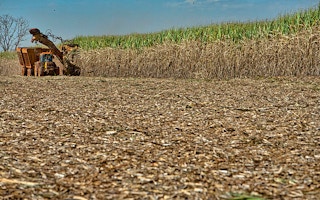One of the touchier areas of scientific research – in much of Europe, at least – is the genetic manipulation of food plants, seaweed and algae to try to produce more food or provide better rates of conversion into biofuels. But across the Atlantic genetically-modified crops (GMOs) are increasingly a different story.
They are a deeply controversial subject because early versions of GM food crops had to be dosed in highly toxic chemicals, and claims of higher yields and better nutrition were unproven. It some cases they caused severe environmental problems, and the European Union maintains a ban on many varieties to this day.
But in the US there has been more acceptance of GMOs as a way of extracting more money from farming, and scientists are encouraged to continue to develop new crops with modified genes.
Two global staples, sugarcane and soya, are being researched by teams from the University of Illinois. One group at its College of Agricultural, Consumer and Environmental Sciences (ACES) has shown that sugarcane can be genetically engineered to produce oil in its leaves and stems for biodiesel production. Surprisingly, the modified sugarcane plants also produced more sugar, which can be used for producing ethanol.
Bigger earners
To compete with traditional crops GMOs have to show they can be more profitable, and the Illinois scientists claim that their sugarcane would produce five times the income of soya and twice as much as corn.
Perhaps more importantly, this sugarcane can be grown on marginal lands in what are known as the Gulf states – Texas, Louisiana, Mississippi, Alabama, and Florida.
“
When we’re trying to meet our food needs for the future, this specific modification is one of the many tools that we’re going to need to rely upon.
Carl Bernacchi, associate professor of plant biology, University of Illinois
“Instead of fields of oil pumps, we envision fields of green plants sustainably producing biofuel in perpetuity on our nation’s soil, particularly marginal soil that is not well suited to food production,” says Stephen Long of the university.
However, as with most genetic research, there is a long gap between promising early results and large-scale planting, leading to the production of bio-diesel and ethanol. Long acknowledges it will take 10 to 15 years for the technology to reach farmers’ fields, but believes that length of time will be necessary to ensure future fuel security. Sugarcane will produce substitutes for both petrol and diesel.
The researchers have published in the journal of the university’s Petross project a paper analysing the first genetically modified sugarcane varieties.
Using a juicer, the researchers extracted about 90 per cent of the sugar and 60 per cent of the oil from the plant; the juice was fermented to produce ethanol and later treated with organic solvents to recover the oil. The team has patented the method used to separate the oil and sugar.
They recovered 0.5 and 0.8 per cent oil from two of the modified sugarcane lines– 67 per cent and 167 per cent more oil than unmodified sugarcane. “The oil composition is comparable to that obtained from other feedstocks like seaweed or algae that are being engineered to produce oil,” says co-author Vijay Singh, director of the Integrated Bioprocessing Research Laboratory at Illinois.
“We expected that as oil production increased, sugar production would decrease, based on our computer models,” Long says. “However, we found that the plant can produce more oil without loss of sugar production, which means our plants may ultimately be even more productive than we originally anticipated.”
More food
The second team, working on soya, is excited by the benefits their research may produce in helping to feed the planet’s growing population in a warming world. Soya grows in sub-tropical conditions and is present in almost all processed food on supermarket shelves across the world.
The university has been genetically modifying soya to produce a greater yield in the conditions that are expected in the future: more carbon dioxide in the atmosphere and much higher temperatures where soya currently grows.
Scientists expect that plants will grow better with more atmospheric CO2, since they need it for photosynthesis. This is known as the carbon dioxide fertiliser effect. However, the extra heat will also cause plants distress and probably wipe out these benefits.
The research under field conditions at an experimental station replicating future climate change subjected the genetically modified soya to the same conditions (including sun, wind, rain and clouds) as other Illinois field crops, and found that over three years they consistently yielded better.
“When we’re trying to meet our food needs for the future, this specific modification is one of the many tools that we’re going to need to rely upon,” said Carl Bernacchi, an associate professor of plant biology at the university.
This story was published with permission from Climate News Network.










